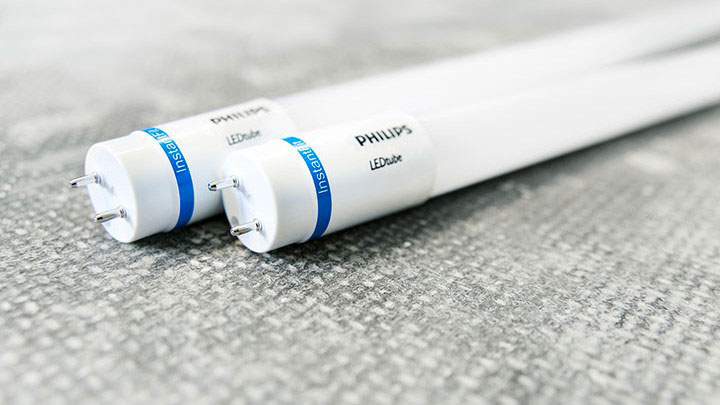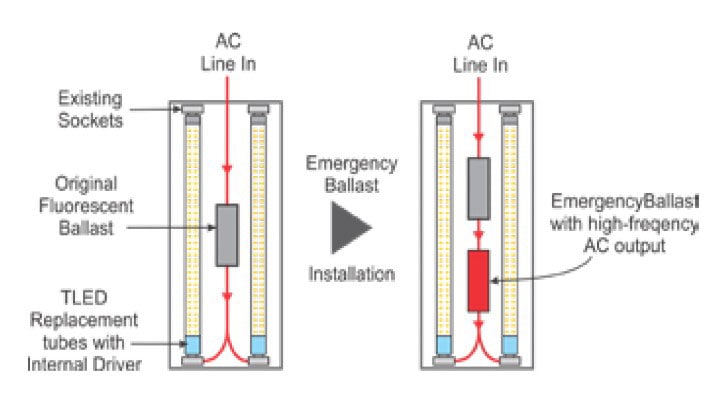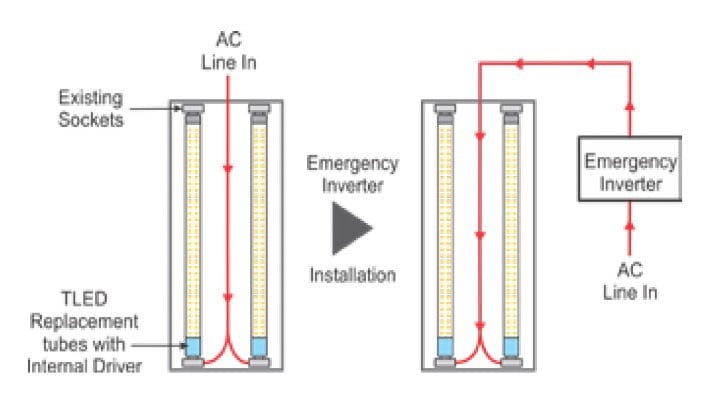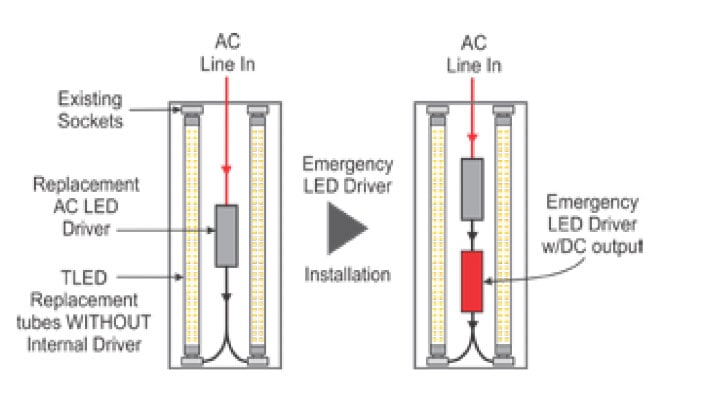
Tubular LED (TLED) lights are a type of LED lamp used to retrofit existing fluorescent lamp fixtures to utilize all the advantages of LED technology like energy efficiency and service life. There are three main types of TLED lamps: Type A, which uses an internal driver and operates on the existing fluorescent lamp ballast; Type B, which uses an internal driver and bypasses the ballast to connect directly to line voltage for power; and Type C, which uses an external driver that replaces the existing ballast. All three of these retrofitted fixtures can be converted to an emergency lighting fixture and utilize different types of emergency technology based on the specific type. As this is only a guide, certified electricians or qualified contractors should be used to convert LED retrofit fixtures into emergency lighting fixtures.
Type A
Type A TLED retrofit lamps are a direct replacement for the fluorescent tubes currently installed in your fixture. They are powered from the original AC fluorescent ballast’s output.
This type of retrofit is the simplest and can easily be done by anyone that can also replace a fluorescent tube. Select Bodine fluorescent emergency drivers, such as the B50 are suitable for this type of lamp.

Type B
Type B TLED replacement lamps have internal drivers that convert AC voltage to DC voltage to power the LED array. These lamps are powered directly from the AC line and are sometimes called “bypass” TLED lamps or “mains operated” TLED lamps.
When emergency lighting is required in these fixtures, an emergency inverter with AC output should be used, like the Bodine ELI emergency inverter series of products.

Type C
Type C TLED replacement lamps are operated from a DC source, the same as a fixed LED light engine. If the TLED replacement lamps do not have internal drivers, an AC LED driver with DC voltage output must be used to replace the fluorescent ballast.
Likewise, an emergency driver that provides DC output must be used to drive the TLED lamps when normal power fails, like the Bodine BSL LED emergency driver series of products.

Retrofit TLED Emergency Lighting Considerations
There are always a few potential compatibility issues that can arise when attempting to retrofit older technology with modern technology. A common issue that arises in applications is when there is already a fluorescent emergency lighting product in place prior to the retrofit.
Previous fluorescent lamp installations may be using an emergency ballast that is incompatible with TLED lamps. In this case, it will be necessary to remove the existing emergency ballast and replace it with an emergency product suitable for the type of TLED lamp to be used (Type A, B, or C). Also, the age of the existing emergency product should be considered. Even if the existing emergency ballast used in the previous installation is compatible with the TLED lamps being used or is over 5 years old, consider replacing it. The end results is a system that should not only provide many years of maintenance free operation, but will also offer the latest technology in light engines and emergency lighting.
Due to lumen efficiency advances in LED versus fluorescent technology, the exact same emergency lighting layout may potentially not be applicable. In some situations, where two fluorescent fixtures were needed to meet Life Safety requirements. However, due to improved lumen output of LED lamps, only one fixture maybe sufficient.
Besides lumen efficiency, light distribution is an important performance factor that also impacts emergency lighting. While fluorescent lamps are essentially omnidirectional, the majority of TLED lamps limit beam angle, affecting the light pattern of some luminaires.
It should also be noted that all TLED types can utilize Bodine ELI emergency inverters to convert a retrofit TLED fixture into an emergency lighting fixture. If there is any doubt, a Bodine ELI inverter, such as the ELI-S-250, can be used to power the entire luminaire(s). Additionally, Bodine ELI emergency inverters offer various features to help maximize an emergency lighting layout such as the ability to power multiple fixtures and select Bodine emergency inverters offer patented dimming technology.
To learn more about retrofit TLED lighting and how to convert them into emergency lighting fixtures, contact Bodine today at BodineTech@signify.com or (800) 223-5728, option 2. Bodine offers solutions that can fulfill any retrofit TLED need and has been a leader in emergency lighting for over 50 years.

November 14, 2023
How lighting technology can help reduce risks to migrating birds